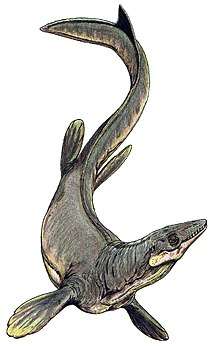Dolichosauridae
Dolichosauridae (from Latin, dolichos = "long" and Greek sauros= lizard) is a family of Late Cretaceous aquatic varanoid lizards closely related to the mosasaurs. The family contains seven genera.
| Dolichosauridae | |
|---|---|
| Fossil skeleton of Pontosaurus | |
| Scientific classification | |
| Kingdom: | Animalia |
| Phylum: | Chordata |
| Class: | Reptilia |
| Order: | Squamata |
| Clade: | Ophidiomorpha |
| Family: | †Dolichosauridae Gervais, 1852 |
| Genera | |
Description
Dolichosaurus was a small marine squamate at about 0.5 to 1 meter in total length.[2] Coniasaurus was similarly sized at about 0.5 meters in length.[3] They were elongated (especially apparent in the neck) marine lizards with reduced limbs and small, thin heads. Dolichosaurs may have occupied a niche similar to the earlier nothosaurs and modern sea snakes, in using their thin heads to feed in crevices and narrow spaces along coral reefs and rocky shores.[2]
The degree to which the limbs were reduced suggest that the dolichosaurs would have been unable to generate any significant movement on land, and they thus likely spent most of their time underwater.[2] Though the reduction of the limbs have no obvious evolutionary advantage, it is an adaptation that might be shared with early snakes.[4]
History of discovery
Both of the genera routinely referred to the Dolichosauridae, Dolichosaurus and Coniasaurus, were described by Richard Owen in 1850 based on specimens of Cenomanian age collected from the Lower Chalk of southeastern England.[5] The unusually large number of dorsal and cervical vertebrae present in Dolichosaurus prompted it to be named as a new genus and Coniasaurus could be distinguished from known Cretaceous lizards by dental characteristics.[5] Nopcsa (1908)[6] restudied the specimens discovered by Owen and described several new specimens of Coniasaurus and Dolichosaurus.
Classification
Both known species of Coniasaurus, C. gracilodens and C. crassidens, are known from disarticulated skulls with isolated vertebral elements. In contrast, Dolichosaurus longicollis, the only species of Dolichosaurus, is known from postcranial skeletons with only very fragmentary skulls and no teeth. This has made the exact nature of their relation difficult to determine.[2]
Coniasaurus and Dolichosaurus are generally considered to be either nested within basal mosasauroids as a third group alongside mosasaurs and aigialosaurs,[6] or as the sister group to the mosasauroids.[7] The difficulties in establishing more certain relationships not only between the Dolichosauridae and the Mosasauroidea, but also between Dolichosaurus and Coniasaurus, arise from the nature of the fossil remains referred to the genera. With Coniasaurus largely lacking postcranial material and Dolichosaurus largely lacking cranial material, they are difficult to compare with each other.[2]
Studies that propose a close relation between snakes and mosasauroids in a group dubbed Pythonomorpha demonstrate the importance of Dolichosaurus, Coniasaurus and other Late Cretaceous marine squamates in squamate phylogeny and evolutionary history.[7] The hypothesis suggesting that snakes, mosasaurs, aigialosaurs and dolichosaurs share a common aquatic ancestor is not universally accepted and stands in stark contrast with the previously widespread hypothesis of snakes having a fossorial origin.[2]
The cladogram below is based on Palci and Caldwell (2010a), Caldwell and Palci (2010b),[8][9] placing the Dolichosauridae as a sister group to modern snakes and their closest ancestors.
| Anguimorpha |
| ||||||||||||||||||||||||||||||||||||||||||||||||||||||||||||||||||||||||||||||||||||
References
- Ilaria Paparella; Alessandro Palci; Umberto Nicosia; Michael W. Caldwell (2018). "A new fossil marine lizard with soft tissues from the Late Cretaceous of southern Italy". Royal Society Open Science. 5 (6): 172411. doi:10.1098/rsos.172411. PMC 6030324. PMID 30110414.
- Caldwell, Michael W. (2000-12-01). "On the aquatic squamate dolichosaurus longicollis (cenomanian, upper cretaceous), and the evolution of elongate necks in squamates". Journal of Vertebrate Paleontology. 20 (4): 720–735. doi:10.1671/0272-4634(2000)020[0720:OTASDL]2.0.CO;2. ISSN 0272-4634.
- Caldwell M.W. & Cooper J.A. (1999). "Redescription, palaeobiogeography and palaeoecology of Coniasaurus crassidens Owen, 1850 (Squamata) from the Lower Chalk (Cretaceous; Cenomanian) of SE England" (PDF). Zoological Journal of the Linnean Society. 127 (4): 423–452. doi:10.1111/j.1096-3642.1999.tb01380.x.
- Lee, Michael S. Y.; Caldwell, Michael W. (1998-10-29). "Anatomy and relationships of Pachyrhachis problematicus, a primitive snake with hindlimbs". Philosophical Transactions of the Royal Society B: Biological Sciences. 353 (1375): 1521–1552. doi:10.1098/rstb.1998.0308. ISSN 0962-8436. PMC 1692386.
- Owen, R. 1850. Description of the Fossil Reptiles of the Chalk Formation; pp. 378–404 in F. Dixon (ed.), The Geology and Fossils of the Tertiary and Cretaceous Formations.
- Nopcsa, F. 1908. Zur kenntnis der fossilen Eidechsen. Beitra¨ge zur Pala¨ontologie und Geologie O¨sterreich-Ungarns und des Orients 21: 33–62.
- Caldwell, M. (1999-01-01). "Squamate phylogeny and the relationships of snakes and mosasauroids". Zoological Journal of the Linnean Society. 125 (1): 115–147. doi:10.1006/zjls.1997.0144. ISSN 0024-4082.
- Alessandro Palci & Michael W. Caldwell (2010a). "Redescription of Acteosaurus tommasinii von Meyer, 1860, and a discussion of evolutionary trends within the clade Ophidiomorpha". Journal of Vertebrate Paleontology. 30 (1): 94–108. doi:10.1080/02724630903409139.
- Caldwell, Michael W.; Palci, Alessandro (2010). "A new species of marine ophidiomorph lizard,Adriosaurus skrbinensis, from the Upper Cretaceous of Slovenia". Journal of Vertebrate Paleontology. 30 (3): 747–755. doi:10.1080/02724631003762963.
